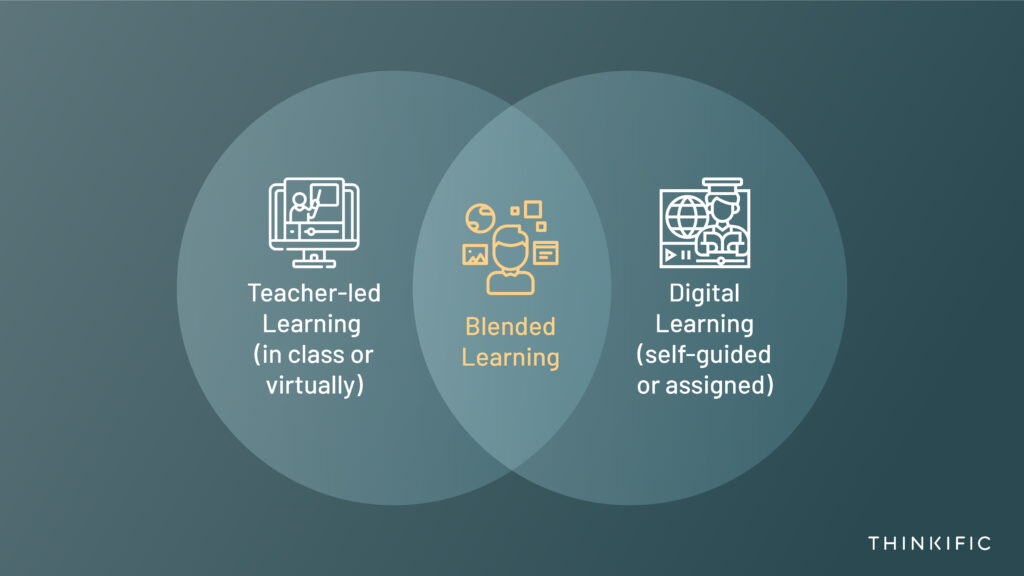With the internet being crucial to daily life and getting a huge push from the pandemic, blended learning has become a key part of the educational experience. Teachers and other educators are having to learn how to create materials that combine the best of both worlds while still ensuring students are assessed appropriately.
What is blended learning?
There are many different forms that blended learning can take, but they generally boil down to this:
Blended learning is an approach to learning that integrates online education materials and place-based classroom methods.
Typically, it means teachers and students must be present physically, but students have some control over when, how, and where they access learning materials.
Place-based doesn’t necessarily mean the teacher must be present in the same room as the student. It can integrate webinars, for example, and online lectures. While the teachers and students are present in the same virtual space, they’re not physically together.
As a result, blended learning can take place entirely online using a mixture of tools to create a fully integrated educational experience.

Related: Synchronous vs Asynchronous Learning: How To Use Both
Why is blended learning effective?
Blended learning works because it’s very similar to the traditional model schools have used for decades. This means students get guidance when they need it, but there are also elements of self-study — essentially homework.
But unlike the traditional model, students have full access to learning materials wherever they are. This means they can learn at their own pace, and they can also cross-reference learning materials to create a fuller picture. This has significant benefits for a variety of learning styles. In addition, blended learning removes some stress because students can go at their own pace.
Easy engagement
Engagement is another key benefit of blended learning. Most teachers understand that there is a range of attention spans in any classroom, with some students listening attentively and others distracted very easily. And much of this may be caused by things outside the students’ control.
Blended learning offers an opportunity to many students who may be affected by issues in their own lives to work at their own pace and engage with the materials on their own terms. It reduces the need to be physically present in the classroom. Students with longer commutes (30 minutes or more) have less time for sleep and exercise, but a blended learning model could help even the playing field.
The benefits don’t stop there. Online collaboration provides opportunities for students to work together in a structured environment. This means teachers can check the progress of group projects as they’re happening, making it easier to identify where specific students are falling behind. It also ensures that students have a record of what they’ve done using a variety of collaborative tools. Accountability is much easier, reducing the risk of group projects failing because of one individual.
Accommodates disabilities
Students with disabilities, notably hearing and sight disabilities, may benefit from the increased accessibility that blended learning models offer. Source material can easily be read using text readers, and those with hearing difficulties may be able to access transcripts.
And online calendars let teachers notify students about tests, allowing each student to easily sync their own calendar with a varied schedule. This ensures that students with disabilities are fully informed, and it has benefits for those without — a student can miss a live session but still be informed of upcoming events.
Related articles:
- What Is Universal Design For Learning? (Examples & Best Practices)
- The Most Common Barriers to Learning – And How to Overcome Them
Progress tracking
Progress tracking is also key to the blended learning experience. Online tests deliver instant results, and they’re often self-marking. This makes it easier for teachers to quickly check where students need help and identify areas where additional classroom time may be needed if the class is struggling.
What blended learning models work best for online courses?
There are numerous types of blended learning, including:
- Remote blended learning
- Station rotation blended learning
- Lab rotation blended learning
- Individual rotation blended learning
- Flex blended learning
- Flipped classroom blended learning
- Self-directed blended learning
- Inside-out blended learning
- Outside-in blended learning
- Supplemental blended learning
- Mastery-based blended learning
The most obvious version of blended learning for online use is remote blended learning, where students primarily complete coursework online, only meeting with the teacher as needed. However, this is limiting, because students need some sort of face-to-face time on a regular basis. Face-to-face time, however, can include scheduled small-group activities, individual tutoring sessions, and tutorials.
Station rotation/lab rotation blended learning
Station rotation blended learning means that students rotate through different “stations” throughout the lesson. For example, the stations might be organized as follows:
- Teacher station
- Independent practice station
- Collaborative/activity station
- Tech station
This is ideal for students with a variety of abilities, as not everybody needs the same lesson. Adding in a tech station (potentially the lab part) makes it easy to assess knowledge.
Consequently, teachers can set up different groups for each activity and bring the groups together when they need to move to another activity.
These are often used for elementary students to help them grasp key principles, where different learning methods can be accommodated.
A variant of this is individual rotation blended learning, where students only visit some of the stations as set by the teacher. Some students can improve their skills by practicing the activity straight away, whereas others may need additional help from the teacher. Other students may work best collaborating, helping each student reinforce their knowledge.
Flex blended learning
This is an online-heavy model where students complete the bulk of their education through homework and self-directed activities. However, educators are available for questions when students require them.
In a traditional flex environment, the bulk of learning still happens on campus, but it’s easy to see how it can be transferred fully online, with Zoom calls and messaging standing in for a visit to the teacher’s office.
This is suitable for students who need little supervision and have high motivation to complete the course.
Flipped classroom blended learning
This is one of the more common versions of blended learning, where students learn about content at home and then use teaching time to ensure they have a good handle on the concepts of the subject. Essentially, this is remote learning with tutorials, webinars, and face time to point them in the right direction. It’s flipped because the classroom space is no longer an area for teaching core concepts but for practicing.
This can be ideal for students who need more time to grasp core subjects, but it also helps promote student-centered learning and collaboration. Tools such as Thinkific Live Lessons can help you host within Thinkific with a few clicks.
Self-directed blended learning
In this model, virtually all learning is self-directed. As a result, students create their own courses, with the main goal being to understand the subject they define.
For subjects like history, for example, this is fairly practical, as students can explore a particular part of history and show they understand it through a thesis or dissertation. This is suitable for students who don’t require much guidance, but it can be difficult for students who require clear learning pathways.
Inside-out/outside-in blended learning
The emphasis on these blended learning models is to use the classroom as a source of knowledge and discussion, but the lesson may not begin or end in the classroom itself.
With inside-out blended learning, the lesson begins in the classroom but may end outside in the community. This might be ideal for subjects that require practical experience, for example, and those that lend themselves well to working in the community. It doesn’t necessarily reduce teaching time, however, and it can be difficult for students who struggle to work independently.
Outside-in blended learning involves bringing outside experiences into the classroom. Rather than setting up students with knowledge and asking them to reinforce it, it requires students to experience something in a non-academic environment and then explore it in the classroom. Again, students who struggle to work independently may find this difficult.
Supplemental blended learning
This form of blended learning treats either the classroom or the online space as supplemental to the other. Essentially, one form dominates, with the other acting as a supplementary backup.
This can cover a huge range of other blended learning types, so it’s not the most helpful definition.
Mastery-based blended learning
With mastery-based blended learning, students have to demonstrate mastery of the subject before moving onto the next stage. They may use online and face-to-face teaching, but the key role is in designing assessments that show they have mastery of the subject rather than merely being able to regurgitate an answer.
This is ideal for areas where mastery is critical, but it can be difficult to design tests that show mastery.
What tools can you use for blended learning?
Zoom is perhaps the most ubiquitous tool used for blended learning, due to its easy accessibility, universal accessibility and compatibility, and competitive price point. It’s designed for face-to-face interaction, allowing multiple group calls.
However, Zoom on its own isn’t quite enough for a true blended learning experience, although it can be an important facet. Other tools to create take-home learning materials and design effective engagement solutions are vital.
Thinkific
Thinkific lets you share your knowledge using its simple upload-drag-and-drop platform, and you don’t have to know anything about coding. You can share:
- Videos
- Text
- Downloads
- Quizzes and surveys
- Discussions
- Adobe Captivate and Articulate files
In addition, you can set up prerequisite lessons, evergreen and time-sensitive content, cohorts, and even membership sites, and you can support multiple instructors.
You can create the perfect learning environment for your students with Thinkific’s easy-to-use learning experience platform – try them for free today!
Motrain
Sometimes, it’s not enough to have a well-designed website with great course materials. To engage students, it’s useful to have a way to keep their attention.
Motrain is a gamification app on Thinkific that rewarding self-paced learning activities, like completing an online course lesson, or a quiz. As students complete milestones, they earn virtual coins, which can be redeemed for real prizes. And it integrates with Thinkific!
How does eLearning support blended learning?
Blended learning usually involves some form of eLearning. In some cases, it may be a supplement to the classroom, but in a truly blended learning experience, eLearning plays an integral role. It might involve:
- Self-paced online courses
- Online tests
- Webinars and tutorial sessions
- Prerecorded lectures
- Live lectures
- Structured research
eLearning can be a complete substitute for traditional learning, but that isn’t always the endgame. Classroom time is extremely useful for students, and allowing students to blend classroom time with eLearning opportunities will help you make the most of that time.
Blended learning tips
Consolidation is key
Having numerous log-ins and platform compatibilities isn’t conducive to a good blended learning environment. Simplifying the number of platforms you use means fewer workflows to remember, and it also means students get a consistent learning experience across each teacher.
Allow class time to perfect blended learning
Not every student has an intuitive grasp of blended learning programs — in fact, most students need some help mastering the basics at first. Allocate classroom time where possible to blended learning programs before using it as a key part of the educational experience.
Students may need help creating notes from a video, accessing key files, and running certain programs. Using classroom time to teach this can help solve a lot of issues further down the line.
Blended learning is all about teaching, not technology
It’s easy to focus on the technological aspects of blended learning rather than the teaching, but that’s not how it should be. Solutions should be focused on teaching and increasing your effectiveness as a teacher rather than the technology underpinning it. That’s not to say technology isn’t important — of course it is. But it shouldn’t be your primary consideration.
Easy collaboration is crucial
No matter what solution you end up using, collaboration is vital. You may need to collaborate with other teachers to create learning materials, but more importantly, your students need to collaborate, as well. A great learning solution should be able to integrate collaboration across the board, making group projects easy.
Ready to implement blended learning?
With Thinkific, it’s easy to create online learning experiences to complement your in-person class. with blended learning. Try it for free today!








